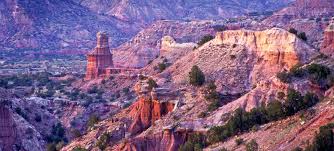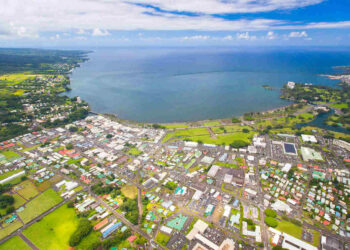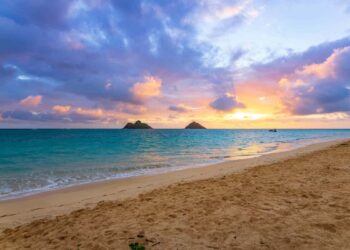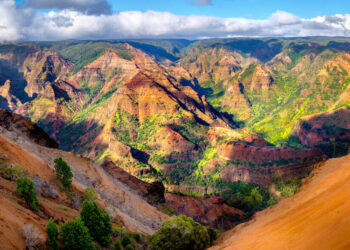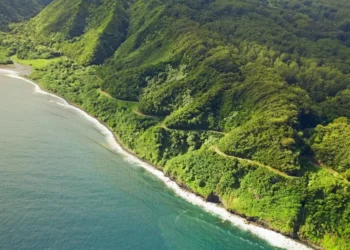Palo Duro Canyon State Park stretches across the Texas Panhandle, a realm where the earth splits wide to reveal a spectacle of raw beauty and ancient silence. Its walls, carved by wind and water over eons, rise in hues of red, ochre, and gold, a stark contrast to the flat plains above. This canyon, a gash in the land’s surface, holds tales of prehistoric life, native tribes, and settlers who braved its depths. It stands as a monument to nature’s craft, unyielding and vast, a place that commands reverence through its sheer scale and stillness.
A Fact of Note: Palo Duro ranks as the second-largest canyon in the United States, its expanse trailing only the Grand Canyon. This measure, a full 120 miles long and up to 20 miles wide in parts, marks it as a titan of the wild, a truth that anchors its quiet might.
Places to Visit: An Overview
The park’s features unfold as distinct domains, each a testament to its rugged splendor.
Lighthouse Rock: At the canyon’s heart, Lighthouse Rock stands as its most famed sentinel. This formation, a pillar of stone shaped by relentless erosion, rises sharp against the sky, its cap a flat crown atop a narrow neck. Trails lead to its base, winding through scrub and stone, offering views that frame its solitude amid the vastness.
Capitol Peak: Capitol Peak looms as another bastion, its slopes layered in bands of color—red clay, white gypsum, yellow sandstone. Its crest affords a perch over the canyon’s breadth, a vantage where the land’s folds stretch out like a map of time itself.
Spanish Skirts: Named for their flared, skirt-like shape, the Spanish Skirts present a cluster of formations along the canyon’s edge. Their hues shift with the sun—deep rust at dawn, pale gold at noon—a display that speaks of the earth’s slow artistry.
Fortress Cliff: Fortress Cliff cuts a sheer face along the canyon’s rim, its height a wall of stone that drops to the floor below. Its surface bears scars of wind, a rough shield that guards the park’s inner reaches, its base strewn with boulders fallen long ago.
Visitor Center Area: Near the entrance, the Visitor Center overlooks the canyon’s expanse, its deck a window to the chasm. Displays within trace the land’s past—fossils of ancient beasts, tools of tribes—while outside, the view holds the eye with its sweep of color and depth.
How to Reach
Palo Duro Canyon State Park lies accessible through routes of road and sparse transit, each a key to its wild gate.
Road Travel: The park rests 25 miles southeast of Amarillo, reached via State Highway 217 from Canyon, Texas. The road twists from flat plains to the canyon’s rim, a descent that shifts from open fields to steep drops. From Amarillo, Interstate 27 leads south to Canyon, then east, a path of 30 miles total, its final stretch a narrow lane past scrub and stone. Dust rises here when rains fail, a mark of the dry land.
Air Travel: Amarillo’s Rick Husband International Airport, the nearest hub, sits 35 miles northwest. Flights link to Dallas, Denver, and beyond, though small. From there, rental vehicles or sparse shuttles bridge the gap—Highway 60 to Canyon, then 217, a haul of rough turns and open sky.
Local Access: No rails reach the park, nor buses run its edge. Within, trails and a single road—paved in parts, gravel in others—thread the canyon, passable by car or foot. Cabins and campsites dot the floor, tied by paths that wind slow, their dust a constant companion.
Frequently Asked Questions Concerning Palo Duro Climate
What governs the weather here?
The canyon’s climate swings fierce. Summer peaks past 100°F, a dry heat that bakes the stone. Spring and fall range from 60°F to 85°F, their air crisp till sun climbs high. Winter dips to 30°F, winds cutting sharp across the rim.
What attire suits its demands?
Light weave wards off heat, a broad hat meets the sun’s glare. Boots grip the trails, their soles a shield on rock. Cold bites at night—cloth layers hold warmth. Rain, rare but swift, calls for a thin cover.
Does weather alter plans?
Heat presses hard midday—dawn or dusk spares the burn. Winter winds chill the rim, though the floor holds milder air. Plans bend to its will, but the land waits steady.
What marks its nature?
Dust storms rise when winds turn wild, a haze that stings the eyes. Flash floods, though scarce, carve the floor after heavy rain, their mark a sudden rush then gone.
More of Palo Duro
The park yields depths beyond its chief marks. Sad Monkey Overlook peers down a steep drop, its name a nod to lore lost in time, the view a sweep of cliffs and hollows. Goodnight Peak, named for a rancher who knew this land, stands rugged, its slopes a scramble for those who seek its crown.
Trails thread the canyon—Rock Garden climbs through boulders, its path a test of footing, while Givens, Spicer & Lowry loops the floor, past junipers and dry creeks, their beds cracked till rains return. Wildlife stirs here—mule deer bound the slopes, hawks wheel above, their cries a thin note in the wind.
The Pioneer Amphitheater cuts into the canyon’s side, its stone seats a stage for summer plays—tales of Texas grit under stars. Cabins of old wood dot the land, their roofs low, built by hands that knew the Depression’s lean days. Springs hide in corners—small pools where water seeps, a rare green amid the red.
Beyond the park’s edge, the plains roll flat, their sameness a foil to the canyon’s plunge. Old ranches linger near, their fences sagging, a hint of herds that once roamed free. The town of Canyon holds a museum—Panhandle-Plains—its walls full of bones and beads, a tie to the land’s deep past.
In Final Words
Palo Duro Canyon State Park endures as a realm of hard beauty, its cliffs a record of time unbent—Lighthouse’s lone stand, Fortress’s stern face, the floor’s quiet scars. It calls not for quick glance but for steady gaze, a Texas wild that holds its own, its silence loud with age.
